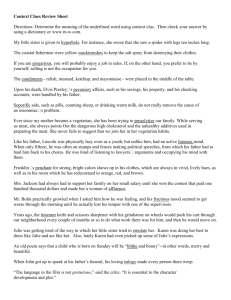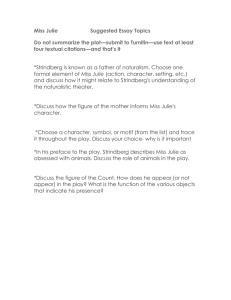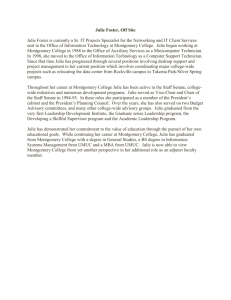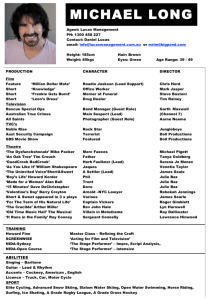The play Miss Julie by Swedish playwright August Strindberg was
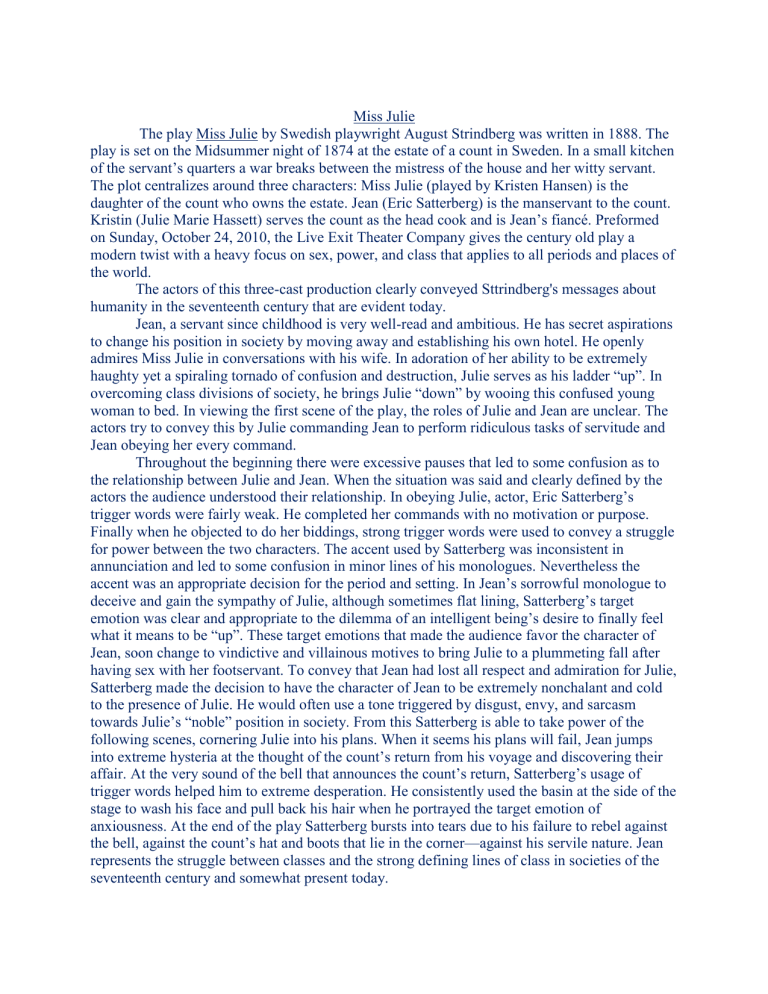
Miss Julie
The play Miss Julie by Swedish playwright August Strindberg was written in 1888. The play is set on the Midsummer night of 1874 at the estate of a count in Sweden. In a small kitchen of the servant’s quarters a war breaks between the mistress of the house and her witty servant.
The plot centralizes around three characters: Miss Julie (played by Kristen Hansen) is the daughter of the count who owns the estate. Jean (Eric Satterberg) is the manservant to the count.
Kristin (Julie Marie Hassett) serves the count as the head cook and is Jean’s fiancé. Preformed on Sunday, October 24, 2010, the Live Exit Theater Company gives the century old play a modern twist with a heavy focus on sex, power, and class that applies to all periods and places of the world.
The actors of this three-cast production clearly conveyed Sttrindberg's messages about humanity in the seventeenth century that are evident today.
Jean, a servant since childhood is very well-read and ambitious. He has secret aspirations to change his position in society by moving away and establishing his own hotel. He openly admires Miss Julie in conversations with his wife. In adoration of her ability to be extremely haughty yet a spiraling tornado of confusion and destruction, Julie serves as his ladder “up”. In overcoming class divisions of society, he brings Julie “down” by wooing this confused young woman to bed. In viewing the first scene of the play, the roles of Julie and Jean are unclear. The actors try to convey this by Julie commanding Jean to perform ridiculous tasks of servitude and
Jean obeying her every command.
Throughout the beginning there were excessive pauses that led to some confusion as to the relationship between Julie and Jean. When the situation was said and clearly defined by the actors the audience understood their relationship. In obeying Julie, actor, Eric Satterberg’s trigger words were fairly weak. He completed her commands with no motivation or purpose.
Finally when he objected to do her biddings, strong trigger words were used to convey a struggle for power between the two characters. The accent used by Satterberg was inconsistent in annunciation and led to some confusion in minor lines of his monologues. Nevertheless the accent was an appropriate decision for the period and setting. In Jean’s sorrowful monologue to deceive and gain the sympathy of Julie, although sometimes flat lining, Satterberg’s target emotion was clear and appropriate to the dilemma of an intelligent being’s desire to finally feel what it means to be “up”. These target emotions that made the audience favor the character of
Jean, soon change to vindictive and villainous motives to bring Julie to a plummeting fall after having sex with her footservant. To convey that Jean had lost all respect and admiration for Julie,
Satterberg made the decision to have the character of Jean to be extremely nonchalant and cold to the presence of Julie. He would often use a tone triggered by disgust, envy, and sarcasm towards Julie’s “noble” position in society. From this Satterberg is able to take power of the following scenes, cornering Julie into his plans. When it seems his plans will fail, Jean jumps into extreme hysteria at the thought of the count’s return from his voyage and discovering their affair. At the very sound of the bell that announces the count’s return, Satterberg’s usage of trigger words helped him to extreme desperation. He consistently used the basin at the side of the stage to wash his face and pull back his hair when he portrayed the target emotion of anxiousness. At the end of the play Satterberg bursts into tears due to his failure to rebel against the bell, against the count’s hat and boots that lie in the corner—against his servile nature. Jean represents the struggle between classes and the strong defining lines of class in societies of the seventeenth century and somewhat present today.
Julie represents struggle between man and woman in one human being resulting in her internal struggles. Julie was raised by her mother to resent men and never submit herself to the command of a man. Julie’s mother wanted to defy society’s separate spheres for men and woman and emphasized on acting like a man. This caused a great amount of conflict between Julie’s mother and father. Julie is a heap of disorder in result from an unclear definition of her own persona from childhood. She desires to come “down” from her social status to feel what it is to touch the ground and see who she truly is. Upon Julie’s initial entrance, after her description as a wild and untamed woman in the conversation between Jean and Kristin, she bursts through the door and bids that Jean continue to dance with her at the Midsummer night festival. In this first scene, actor, Kristen Hansen’s decision to include a significant amount of pauses decreases the intensity of what is said. This decision contradicts the descriptions of Julie. It also makes the audience question if she is truly as wild as described, but simply a strong-willed woman that does desire acceptance from her society. As the play progresses the strength of Hansen’s power over the scene builds exponentially. This is portrayed by Hansen jumping onto the kitchen table as she commands Jean to kiss her toes. Hansen’s movement provides a clear definition of power, although it is not completed with natural purpose. In the beginning of the play the trigger emotions were not strong enough to motivate such powerful movement throughout her monologues. As the plot intensifies, Julie is brought into a dilemma in dealing with her affair with Jean. She must contemplate facing her society, her father, and dealing with the values instilled by her mother. Hansen is deeply engaged into the character and scenes in which the plot boils. Her trigger emotions of bewilderment and depression combine to lead her into deliria, while sweating and shaking she often stumbles and crumbles to the floor in tears. Julie’s power is entirely lost and the roles are switched: Julie is at service of Jean, seeking his guidance and is at his unforgiving whim. Finally when both characters are at desperation, Julie makes the decision to flee the country. Hansen, completely absorbed into character, parts from her pathetic servant who choking back tears screams, “the first will be the last!” The first to break away from the rules of society for women, men and class will be the last to suffer from its barriers.
Kristin represents morality in a force totally separate from that of Julie and Jean. She has an omniscient point of view of the entire situation, and as woman ahead of her time, finds a safe conclusion in living with her status, her society, and her period. Actor Julie Marie Hassett used her character Kristin to try to establish a relationship between the characters in the ensemble. She does this by using target emotions to give facial reactions to the events between Jean and Julie.
Appearing in few scenes, she often reprimands Jean for taking advantage of such a confused young woman. Hassett shows a deep understanding of the character’s concern for the greater good and the divine way rather than her personal gripe and discontent. The other characters are very intense and internally wound into their struggles. Kristine serves as motherly consoling role when she talks to Julie about God and his plan for each of his children. Hassett’s decisions for this role is effective to an extent, but lack of connections within the entire ensemble makes it difficult for audience to connect all characters together.
The costumes were not specific to any time period. This decision upon the director allowed the performance to lean toward a more contemporary time period. Unlike having the servants and Julie have drastic differences of dress to convey division of class and power, having all characters in similar dress put them all on similar levels. This allowed the audience to receive the greater message regarding human equality.
The blocking, lighting, and staging was carefully choreographed according to the roles of power and importance in each scene; although it was not interwoven with the performance. Each
actor knew their positions and areas of working space, but moved to them systematically rather than naturally. The actors would often turn their back to the audience in completing an action.
These are considered as some of the “don’ts” of theater, yet these decisions of the director were effective in creating a stylistic pattern to the performance. The general pattern of emotions throughout the play tended to dramatically sway up and down. This was engaging for the audience and metaphorically represented the chaos between the characters and the chaos we deal with daily within our own relationships.
The performance was approximately two hours long without an intermission. The actors kept the audience engaged in this highly sentimental and suspenseful performance recommended for all to experience.
